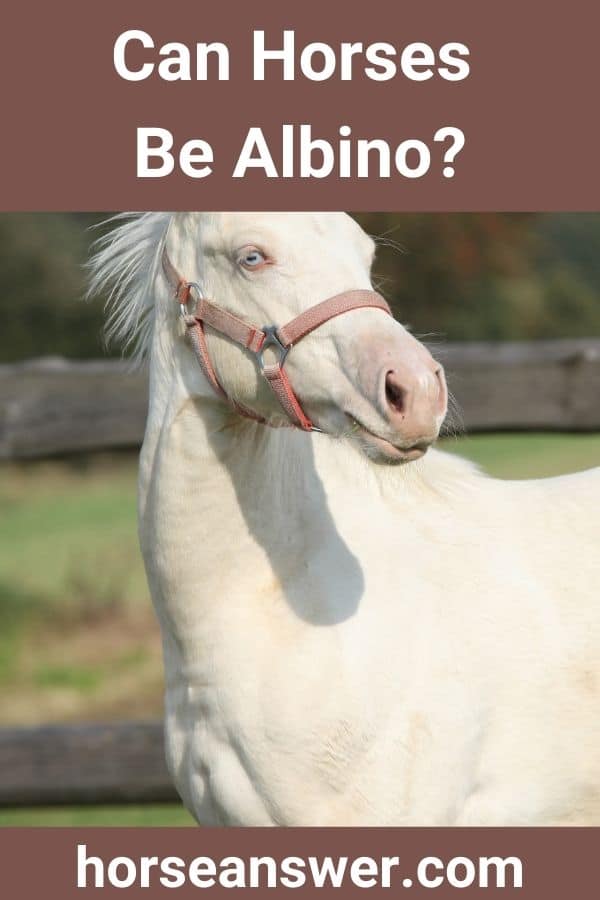Can Horses Be Albino? (Explained!)
When at the races with my son recently, we both noticed a white horse with light pink skin and blue eyes.
My son was really struck by this gorgeous horse and so was I.
We love horses and have a couple of our own, but neither of us had ever seen a horse like this.
My son straightaway asked me a really interesting question that I’d never considered before.
Can horses be albino?
Although white horses like this are common, there is no documented case of a ‘true’ albino horse. Dominant white in horses is caused by an absence of pigment cells, which are normally distributed in animals with albinism. So, while it may be possible, true albinism has never been seen in horses.
So, it’s important to get out of the way that albinism isn’t just something being pigmented white.
It’s a particular condition that manifests in a number of particular ways.
Let’s break down what it means to be albino and some possible reasons there are no albino horses.
Can you have an albino horse?
Before we answer whether albino horses truly exist, we should quickly establish what albino means.
Albinism is a condition that affects the pigmentation of skin, hair, and eyes.
In humans, it makes your skin and hair very pale and can sometimes make your eyes red.
The condition affects the production of melanin.
So, if albinism refers to a specific lack of a particular pigment, then you can see why white horses are not albino.
When horses have white hair, this is caused by the absence of pigment cells called melanocytes.
Albinism does not affect the distribution of melanocytes, only melanin.
White horses, then, lack a different pigment from what makes other organisms albino.
In other animals, this is called piebaldism,
Some registries do list white horses as albino, but these horses always have pigmented eyes—an albino horse would not.
So, no true albino horse exists or has been documented.
Why are there no albino horses?
The lack of melanin which constitutes albinism is caused by a recessive gene.
The horse needs to have two copies of the gene, then, in order to express the albinism; one from each parent.
If only one copy of the gene is present, is has no effect.
White horses are not caused by recessive genes and they don’t breed as true albinos would.
True albinism is effectively non-existent in horses, then.
They lack the gene to produce albino horses.
White horses are the result of a few different genetic patterns.
The genes effectively block darker pigments, turning the horse white.
These are known as depigmentation phenotypes and are as I said caused by areas of skin that lack melanocytes.
How rare is a white horse?
It’s not that rare to see a horse with a white, or roughly white, coat.
However, we can again talk about ‘true white’ horses and they are quite rare.
These horses carry a particular dominant white gene, as opposed to being gray or otherwise not true white.
Gray horses are much more common than white horses, but often they look more gray than white.
White horses are born white and remain white throughout their whole lives, and true white horses of this kind are extremely rare.
They all come from essentially the same line of horses, and there are 27 identified variants across the world today.
None of them are albino.
What are the types of white horse?
The term “true white” horse refers to horses with a specific dominant gene, but there are a few other varieties which have come into being over the years.
The sabino-white are pink skinned like true white horses, with mostly white coats and dark eyes.
These horses are indistinguishable from true white horses without a genetic testing kit.
White born leopards, as they’re known, are another breed of white horse characterized by spotted coats.
These are quite easy to tell apart from other white horses and, still, are not albino.
Not quite white horses
There are a couple of coat color varieties which are usually seen as white but in fact do not fall within the white or true white category.
Gray horses are most commonly mistaken for white or even albino horses.
However, you can quite easily tell gray and true white horses apart by looking at their skin.
True white horses have pink skin, since it lacks the pigmentation cells; gray horses usually have dark, even black, skin.
Many diluted coat colors also appear white, but do not lack the melanocytes which causes the true white pigmentation (or lack of pigmentation) in true white horses.
These are coats like cream, Pearl-Cream and Champagne-Cream.
These are all the product of mixtures of different genes; pearl and champagne genes with cream genes.
Ultimately, you’ve never seen an albino horse, and you may never have even seen a true white horse; albino horses don’t exist, and true white horses are extremely rare.
There are many different potential colors that a horse can be, and most white horses that we see are just a mixture of cream or grey genes.
Albinism in horses is non-existent, then, technically speaking.
True white horses are indeed a much rarer pigment than the more usual dark colors, but white horses still are not true albino.
We do tend to start thinking that albinism is at least existent, if extremely uncommon, in all species.
I know I certainly thought this until recently. But there are no albino horses and there never have been.
